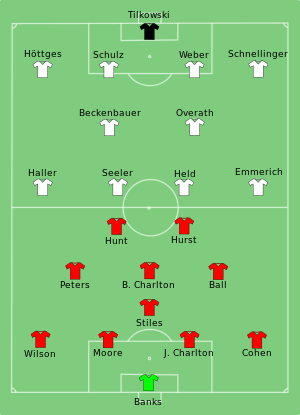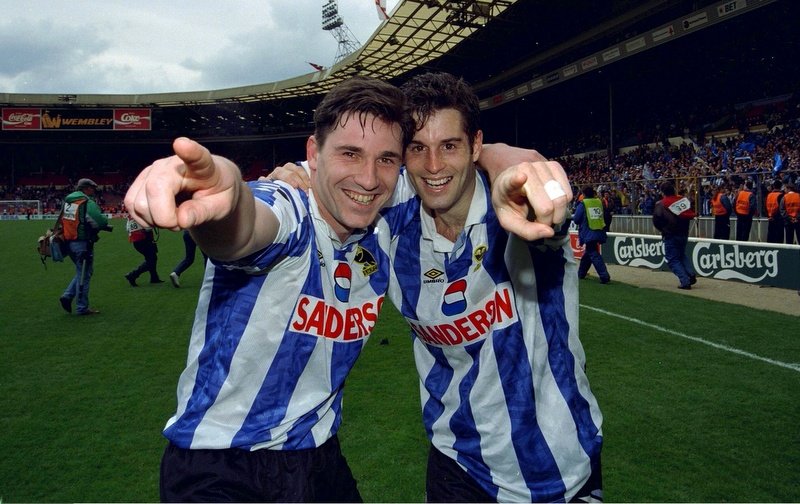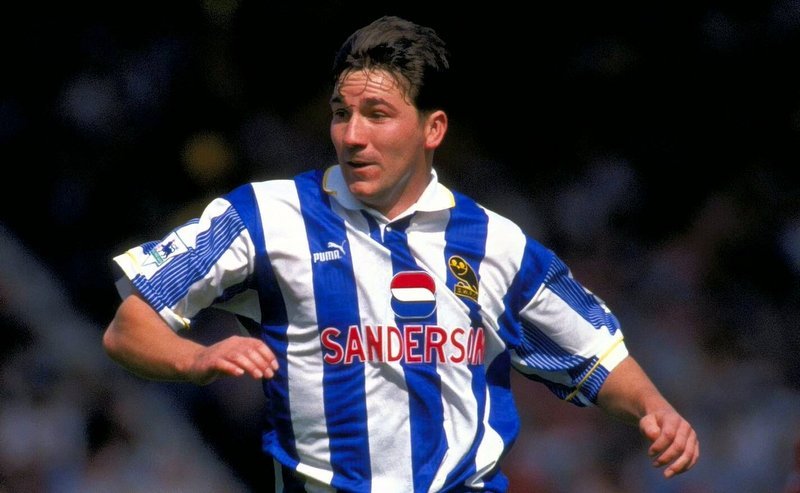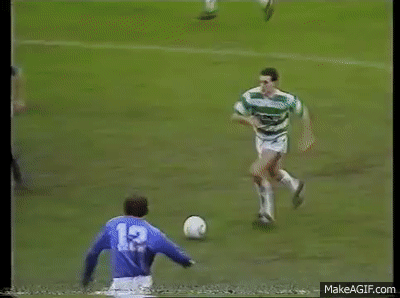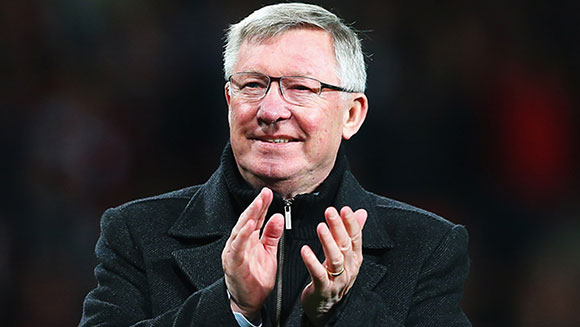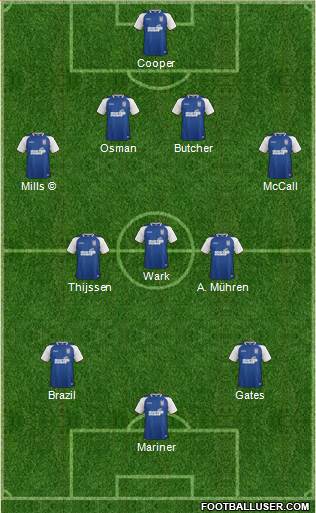Indnyc
Full Member
- Joined
- Aug 3, 2017
- Messages
- 4,543
This is a Pre Premier League draft from 1971/72 to 1991/92 where managers assemble their squads by selecting players based on their playing performance during this time period only. Performances that fall outside this time period should not be considered. Neither should the players performance for their country/international tournaments be considered. As in any team, team tactics and balance also play a part.
Hence please carefully consider the abovesaid factors and evaluate the merits of both teams before voting for the team which in your opinion is likelier to win the match.
Team KM/Invictus/Sjor

VS
Team Gio
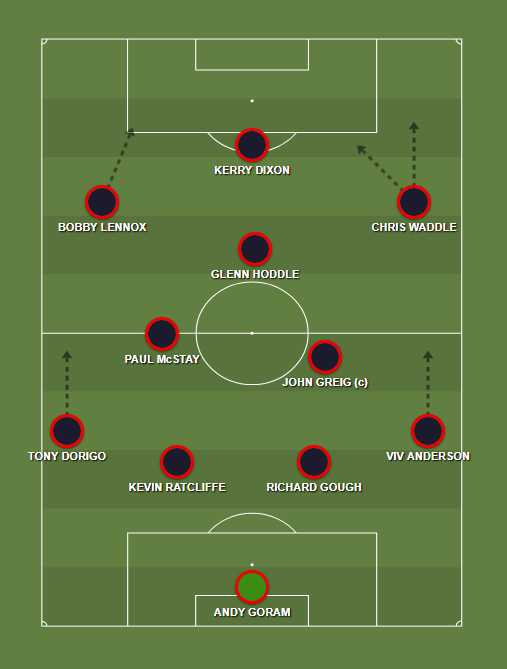
Tactics KM/Invictus/Sjor
At leftback is Crazy Horse Emlyn Hughes: 1977 FWA Footballer of the Year, and the first Liverpool captain to lift the a European title (the 1973 UEFA Cup vs Borussia Mönchengladbach) as well as the European Cup (1997 vs. Borussia Mönchengladbach) as the highlight of 12 trophy-laden seasons. Recalled for his never-say-die attitude, galloping forays into opposition territory and frantic goal celebrations, Hughes excelled at at left-back, in midfield or at the heart of defense.
1977 Ballon D'Or:

At the heart of defense is the proven Ipswich Town partnership of Russell Osman and Terry Butcher:

Together, they set the defensive foundation for the club's ascent — culminating in the 1981 UEFA Cup triumph vs. AZ Alkmaar, and two consecutive runner-up finishes in the league — with Russell complementing Butcher's physically punishing style perfectly.
At rightback is Lee Dixon - a bastion of consistency at Arsenal while being named in the PFA Team of the Year twice, for the seasons 1989–90 and 1990–91. Dixon constantly supported the attacker ahead of him (Callaghan in this configuration), thus combining with him to launch attacks for Arsenal from the right side of the midfield.
On the right side of midfield is Ian Callaghan — no one has played more games for Liverpool than Ian Callaghan. Chances are, no one ever will. Fast, direct and possessing incredible stamina, he was equally proficient as a winger and as a nominal midfielder, and became an established first-team regular from the onset and it was his pinpoint crossing that supplied many a goal for the prolific strike partnership of Hunt and St John. A tireless worker with bags of energy, Callaghan peaked in 1973-74 - a campaign in which he notched his one and only senior hat-trick, overtook Billy Liddell's record of 492 Liverpool appearances, helped the Reds to a second FA Cup success and became the first Anfield player to win the FWA Footballer of the Year award.

At left central midfield is the The Ghost Martin Peters — who offers delectable balance to the team given his versatility and ability to peel wider on occasion as well as offering elegance in distribution, creativity, strong forward runs, yet showing the stamina and discipline to get back and help the defense when required.

Alongside Peters is one of Brian Clough's most trusted generals at Derby County and Nottingham Forest, Archie Gemmill - who also typifies the complete nature of the midfield zone with his industry, eye for pass, tenacity and tactical nous - as well as prowess on the counter-attack:
1978 Ballon D'Or:

And completing the midfield triumvirate is David Platt. Subsequently one of the more prominent British players to go abroad and try his luck there, he is one of the greatest English players of that era. Almost led Aston Villa to an unlikely title, and was voted PFA Player of the Year award in 1989-90. All in all, Platt scored an 50 goals in 121 appearances for Villa during his stay with Villa - while carving out a reputation as a strong running, free-scoring midfielder with a good vision, technique and passing skills while boasting tireless workrate, versatility and reliability as a prolific marksman.
Partnering Mark Hughes as a striker is man who Sir Alex Ferguson wanted to sign 5 times and ended up being rejected all the times is David Hirst. One of the most two footed player of his era, Hirst will compliment Hughes beautifully and like Hughes, he also has an appetite for spectacular goals.
His goal scoring exploits for Sheffield Wednesday:
Spearheading the attack is 1989 and 1991 PFA Players' Player of the Year, and the king of volleys and scissor kicks - Sparky Mark Hughes - a mobile, combative and complete striker whose game transcended mere aggregate goal stats given his importance to the team, accurate distribution, and his ability to rise to the occasion - traits that led to a a slew of memorable and talismanic performances in high profile matches - most notably the 1991 European Cup Winners' Cup where he led the charge with explosive and dramatic goals, and just to highlight his overall game and his proficiency at holding the ball up for oncoming attackers and midfielders, the 1992 League Cup Final vs. Brian Clough's Nottingham Forest:
1991 Ballon D'Or:

Why we should win:
1. Complete and robust midfield - in terms of both quality and structure: While Hoddle is the best midfielder on show here, you could argue that Platt wasn't far behind - and crucially, Platt edges it in terms of tenacity and defensive workrate, the completeness of his game in all phases - which will definitely matter in a game of fine margins. Add Peters and Gemmill to the equation, and that area of the park is packed to the rafters with draft, guile and tactical malleability. Also of crucial importance is the goal-grabbing ability of The Ghost and Platt.
2. Limiting the opposition's attack: pre-Marseille prime Waddle and Lennox face two of the finest fullbacks in the pool with Emlyn Hughes in particular being one of the most determined and astute defenders on show. That will inhibit the opposition to a great degree. Then you have a centerback who didn't-give-an-inch in Butcher, and Gordon Banks — his sample size is a wee bit limited compared with the half-decade from 1966 to 1971 where he was FIFA Goalkeeper of the Year time and again, but he still played 70 matches at Stoke prior to the accident which resulted in 200 stitches in his face and over 100 micro-stitches inside the socket of his right eye.
3. Vibrant attack led by one of the most mercurial attackers in the pool: In a game of fine margins, there's none better than Mark Hughes to lead the charge — twice PFA Players' Player of the Year, as complete and competitive as can be, and one of the great big-match players according to Alex Ferguson, no less:

Tactics Team Gio
Andy Goram
Scotland's greatest ever keeper and a legend at both Hibs and Rangers. In February 1990, World Soccer magazine stated that he had been in 'outstanding form during the last 3 years'. And in 1991 he became Britain's most expensive ever goalkeeper when signing for Rangers for £1.8m, going on to keep 25 clean sheets during his debut double-winning season. Exceptional shot-stopper with razor-sharp reflexes.
Richard Gough
Athletic and imposing, Gough was a classic attack-the-first ball centre half. His dynamism, professionalism and leadership were the bedrock behind Rangers' 9-in-a-row side during a career when he hauled in 21 trophies. Not just an SPL flat-track bully, as he twice almost won the European Cup, first with Dundee United in 1984/85 when they were edged out by Roma in a contentious semi, and second with Rangers as they were a goal away from knocking out Marseille in 1992/93. Given both clubs' form with referees and bribery at the time, he's rather unfortunate not to add a European Cup medal to that collection. Exceptional man-marker, famously shackled Van Basten at Euro '92, who also shone brightly at Spurs making the all-time XIs of the players that each of Graeme Souness, Glenn Hoddle and Gary Mabbutt have played with. Read more...
Kevin Ratcliffe
Captain of Everton at just 23, then the best team in the country, Ratcliffe's defensive prowess made a huge difference in catapulting Everton to the top of the table. His searing pace and reading of the game made him a perfect partner to the more conventional stopper Mountfield. He is a regular in Wales and Everton all-time XIs. Read more...
One of the finest right-backs England has ever produced. A bedrock of Clough's great double European Cup winning Forest team, Anderson won 96% of the vote when fans voted the right-back into their greatest ever XI. Outstanding for Arsenal as well where fans who know their stuff will also rank him as their greatest ever right-back (unless you want to insert George's back 4 unit in en masse). Gangly, dynamic, defensively solid and a keen ball-carrier, Anderson was a modern yet robust full-back.
Solid left-back who was an influential figure for Aston Villa, Chelsea and Leeds. Won the Player of the Year award at all three clubs which was testament to his defensive reliability and positive contributions on the ball. Good crosser who often serviced Dixon at Chelsea. Showed an impressive peak winning the fans' player of the year award during Leeds title-winning season where his stay at Elland Road was described as a 'near-perfect six years' by the Yorkshire Evening Post.
Voted Rangers' Greatest Ever Player, Greig was a born leader, a one-club man whose statue stands outside Ibrox today and remains the only man to have won the treble three times. A combative, commanding and energetic midfielder whose intelligence and understanding of the game enabled him to slip seamlessly across the back line as the needs of his club demanded.
Coveted by the cream of the continent, McStay's loyalty to Celtic gave him legend status at Parkhead but cost him the global legacy his ability and performances deserved. Penetrating passer of the ball who was an all-round, two-way central midfielder. Broke into a stacked Scotland midfield (Souness, Strachan, Wark, McCallister) at just 18 years old and held his place for well over a decade collecting 76 caps. Turned down repeated overtures from Trapattoni's Inter, Wenger's Monaco and Ferguson's United to stay true to Celtic despite their struggles off the park.
One of the most gifted English players of all time. Technically exquisite, Hoddle's two-footedness and eyes-in-the-back-of-his-head vision allowed him to play early and penetrating passes before defences had time to react. Despite operating in the era of English football least conducive to enabling creative players, Hoddle was a sustained success, an almost ever-present in the PFA Team of the Year through the 1980s.
Celtic's greatest ever left winger. Heavy duty goalscorer from out wide scoring a whopping 234 goals during Celtic's 9-in-a-row stretch. Lennox was 27 at the start of the draft period where his record holds up well:
That would be an impressive enough return for a centre-forward, better still for a left winger. Incidentally it's no surprise that the season Celtic's run came to an end was the same season that Lennox was missing for large parts through injury. Lennox aged better than a lot of the Lisbon Lion generation, retaining his searing pace into his early 30s owing much to both his genetic gifts and his professional attitude off the park. He was the last of that great team to retire in 1980, having scored a further 15 goals in his final campaign.
Chris Waddle
Dribbling king whose close control, invention and goal threat made him a handful for even the best opposition. Although he hit double figures 5 times out of 6 from 1983 to 1989, it was his shuffling, shimmying and almost undefendable dribbling style that stood him out from the crowd. His form in England prompted Marseille to make him the 3rd most expensive player of all time (behind Maradona and Gullit) in 1989.
Quick and complete goalscorer who was a ruthless finisher both on the deck in the air. A Chelsea legend (they didn't have many in the 1980s) who struck up an excellent partnership with the winger Pat Nevin and the busy David Speedie. Hit his peak in the mid-1980s, scoring 70 goals in his first two seasons at Stamford Bridge, performing irrespective of the quality of the opposition netting against the likes of Liverpool, Arsenal and Butcher's Ipswich, gaining a spot in the PFA Team of the Season in 1984/85. Fired another 22 goals in during the 1985/86 season before injury struck in January. Lineker's back-up for England for much of the 1980s, and unlucky to be injured after a line-leading demolition (two goals and one assist in a 3-0 win) of West Germany in 1985. Despite Chelsea's relegation in the late 1980s, Kerry fired them back into the First Division and notched another 25 goals in their first season back in 1988/89.
Hence please carefully consider the abovesaid factors and evaluate the merits of both teams before voting for the team which in your opinion is likelier to win the match.
Team KM/Invictus/Sjor

VS
Team Gio

Tactics KM/Invictus/Sjor
At leftback is Crazy Horse Emlyn Hughes: 1977 FWA Footballer of the Year, and the first Liverpool captain to lift the a European title (the 1973 UEFA Cup vs Borussia Mönchengladbach) as well as the European Cup (1997 vs. Borussia Mönchengladbach) as the highlight of 12 trophy-laden seasons. Recalled for his never-say-die attitude, galloping forays into opposition territory and frantic goal celebrations, Hughes excelled at at left-back, in midfield or at the heart of defense.
1977 Ballon D'Or:

At the heart of defense is the proven Ipswich Town partnership of Russell Osman and Terry Butcher:

Together, they set the defensive foundation for the club's ascent — culminating in the 1981 UEFA Cup triumph vs. AZ Alkmaar, and two consecutive runner-up finishes in the league — with Russell complementing Butcher's physically punishing style perfectly.
At rightback is Lee Dixon - a bastion of consistency at Arsenal while being named in the PFA Team of the Year twice, for the seasons 1989–90 and 1990–91. Dixon constantly supported the attacker ahead of him (Callaghan in this configuration), thus combining with him to launch attacks for Arsenal from the right side of the midfield.
On the right side of midfield is Ian Callaghan — no one has played more games for Liverpool than Ian Callaghan. Chances are, no one ever will. Fast, direct and possessing incredible stamina, he was equally proficient as a winger and as a nominal midfielder, and became an established first-team regular from the onset and it was his pinpoint crossing that supplied many a goal for the prolific strike partnership of Hunt and St John. A tireless worker with bags of energy, Callaghan peaked in 1973-74 - a campaign in which he notched his one and only senior hat-trick, overtook Billy Liddell's record of 492 Liverpool appearances, helped the Reds to a second FA Cup success and became the first Anfield player to win the FWA Footballer of the Year award.

At left central midfield is the The Ghost Martin Peters — who offers delectable balance to the team given his versatility and ability to peel wider on occasion as well as offering elegance in distribution, creativity, strong forward runs, yet showing the stamina and discipline to get back and help the defense when required.

Alongside Peters is one of Brian Clough's most trusted generals at Derby County and Nottingham Forest, Archie Gemmill - who also typifies the complete nature of the midfield zone with his industry, eye for pass, tenacity and tactical nous - as well as prowess on the counter-attack:
1978 Ballon D'Or:

And completing the midfield triumvirate is David Platt. Subsequently one of the more prominent British players to go abroad and try his luck there, he is one of the greatest English players of that era. Almost led Aston Villa to an unlikely title, and was voted PFA Player of the Year award in 1989-90. All in all, Platt scored an 50 goals in 121 appearances for Villa during his stay with Villa - while carving out a reputation as a strong running, free-scoring midfielder with a good vision, technique and passing skills while boasting tireless workrate, versatility and reliability as a prolific marksman.
Partnering Mark Hughes as a striker is man who Sir Alex Ferguson wanted to sign 5 times and ended up being rejected all the times is David Hirst. One of the most two footed player of his era, Hirst will compliment Hughes beautifully and like Hughes, he also has an appetite for spectacular goals.
His goal scoring exploits for Sheffield Wednesday:
Spearheading the attack is 1989 and 1991 PFA Players' Player of the Year, and the king of volleys and scissor kicks - Sparky Mark Hughes - a mobile, combative and complete striker whose game transcended mere aggregate goal stats given his importance to the team, accurate distribution, and his ability to rise to the occasion - traits that led to a a slew of memorable and talismanic performances in high profile matches - most notably the 1991 European Cup Winners' Cup where he led the charge with explosive and dramatic goals, and just to highlight his overall game and his proficiency at holding the ball up for oncoming attackers and midfielders, the 1992 League Cup Final vs. Brian Clough's Nottingham Forest:
1991 Ballon D'Or:

Why we should win:
1. Complete and robust midfield - in terms of both quality and structure: While Hoddle is the best midfielder on show here, you could argue that Platt wasn't far behind - and crucially, Platt edges it in terms of tenacity and defensive workrate, the completeness of his game in all phases - which will definitely matter in a game of fine margins. Add Peters and Gemmill to the equation, and that area of the park is packed to the rafters with draft, guile and tactical malleability. Also of crucial importance is the goal-grabbing ability of The Ghost and Platt.
2. Limiting the opposition's attack: pre-Marseille prime Waddle and Lennox face two of the finest fullbacks in the pool with Emlyn Hughes in particular being one of the most determined and astute defenders on show. That will inhibit the opposition to a great degree. Then you have a centerback who didn't-give-an-inch in Butcher, and Gordon Banks — his sample size is a wee bit limited compared with the half-decade from 1966 to 1971 where he was FIFA Goalkeeper of the Year time and again, but he still played 70 matches at Stoke prior to the accident which resulted in 200 stitches in his face and over 100 micro-stitches inside the socket of his right eye.
3. Vibrant attack led by one of the most mercurial attackers in the pool: In a game of fine margins, there's none better than Mark Hughes to lead the charge — twice PFA Players' Player of the Year, as complete and competitive as can be, and one of the great big-match players according to Alex Ferguson, no less:

Tactics Team Gio
WHY WE WILL WIN:
- It's all about getting the best out of Glenn Hoddle. First of all he benefits from the solid midfield platform ahead of the indefatigable Greig and the scheming all-rounder McStay. Secondly, he renews his superb creative partnership with Waddle from Spurs to feed a dominating right flank. And thirdly he can thread tantalising through balls into the paths of off-the-shoulder runners in Lennox and Dixon. Here he doesn't have to face a great deal of natural defensive resistance in the heart of the SIK midfield to impact the game.
- The teams benefits from a serious core of leadership of the greatest ever 'Ger John Greig, the serial winner Richard Gough and the all-conquering-captain-at-23 Kevin Ratcliffe. The influence that central core will have on the rest of the team and the outcome of the game cannot be underestimated.
- Defenders who can match SIK's strengths: Gough's dynamism and combativeness squares up to Hughes' robust target play well; Greig has the defensive nous and experience to track Platt's runs from deep.
- Dixon has a good record against the Butcher and Osman partnership at Ipswich. With the service from Hoddle, Waddle and McStay here, he will be in his element.
Andy Goram
Scotland's greatest ever keeper and a legend at both Hibs and Rangers. In February 1990, World Soccer magazine stated that he had been in 'outstanding form during the last 3 years'. And in 1991 he became Britain's most expensive ever goalkeeper when signing for Rangers for £1.8m, going on to keep 25 clean sheets during his debut double-winning season. Exceptional shot-stopper with razor-sharp reflexes.
Richard Gough
Athletic and imposing, Gough was a classic attack-the-first ball centre half. His dynamism, professionalism and leadership were the bedrock behind Rangers' 9-in-a-row side during a career when he hauled in 21 trophies. Not just an SPL flat-track bully, as he twice almost won the European Cup, first with Dundee United in 1984/85 when they were edged out by Roma in a contentious semi, and second with Rangers as they were a goal away from knocking out Marseille in 1992/93. Given both clubs' form with referees and bribery at the time, he's rather unfortunate not to add a European Cup medal to that collection. Exceptional man-marker, famously shackled Van Basten at Euro '92, who also shone brightly at Spurs making the all-time XIs of the players that each of Graeme Souness, Glenn Hoddle and Gary Mabbutt have played with. Read more...
Kevin Ratcliffe
Captain of Everton at just 23, then the best team in the country, Ratcliffe's defensive prowess made a huge difference in catapulting Everton to the top of the table. His searing pace and reading of the game made him a perfect partner to the more conventional stopper Mountfield. He is a regular in Wales and Everton all-time XIs. Read more...
- English First Division Winner 1984/85 and 1986/87
- European Cup Winners Cup 1984/85
- FA Cup Winner 1984
- PFA Team of the Year 1984/85
One of the finest right-backs England has ever produced. A bedrock of Clough's great double European Cup winning Forest team, Anderson won 96% of the vote when fans voted the right-back into their greatest ever XI. Outstanding for Arsenal as well where fans who know their stuff will also rank him as their greatest ever right-back (unless you want to insert George's back 4 unit in en masse). Gangly, dynamic, defensively solid and a keen ball-carrier, Anderson was a modern yet robust full-back.
- Notts Forest All-Time XI
- European Cup Winner 1979, 1980
- English First Division Winner 1977/78
- PFA Team of the Year 1978, 1980 and 1987
Solid left-back who was an influential figure for Aston Villa, Chelsea and Leeds. Won the Player of the Year award at all three clubs which was testament to his defensive reliability and positive contributions on the ball. Good crosser who often serviced Dixon at Chelsea. Showed an impressive peak winning the fans' player of the year award during Leeds title-winning season where his stay at Elland Road was described as a 'near-perfect six years' by the Yorkshire Evening Post.
- Aston Villa Player of the Year 1985
- Chelsea Player of the Year 1987/88
- Leeds Fans Player of the Year 1991/92
- First Division Winner 1991/92
Voted Rangers' Greatest Ever Player, Greig was a born leader, a one-club man whose statue stands outside Ibrox today and remains the only man to have won the treble three times. A combative, commanding and energetic midfielder whose intelligence and understanding of the game enabled him to slip seamlessly across the back line as the needs of his club demanded.
- SFWA Footballer of the Year 1975/76
- European Cup Winners Cup Winner 1971/72
- Multiple domestic titles and trophies
Coveted by the cream of the continent, McStay's loyalty to Celtic gave him legend status at Parkhead but cost him the global legacy his ability and performances deserved. Penetrating passer of the ball who was an all-round, two-way central midfielder. Broke into a stacked Scotland midfield (Souness, Strachan, Wark, McCallister) at just 18 years old and held his place for well over a decade collecting 76 caps. Turned down repeated overtures from Trapattoni's Inter, Wenger's Monaco and Ferguson's United to stay true to Celtic despite their struggles off the park.
- Scottish PFA Players' Player of the Year 1988
- SFWA Footballer of the Year 1988
- Scottish PFA Young Player of the Year 1983
One of the most gifted English players of all time. Technically exquisite, Hoddle's two-footedness and eyes-in-the-back-of-his-head vision allowed him to play early and penetrating passes before defences had time to react. Despite operating in the era of English football least conducive to enabling creative players, Hoddle was a sustained success, an almost ever-present in the PFA Team of the Year through the 1980s.
- UEFA Cup winner: 1984
- FA Cup winner: 1981, 1982
- PFA Young Player of the Year: 1979–80
- PFA Second Division Team of the Year: 1977–78
- PFA First Division Team of the Year: 1979–80, 1981–82, 1983–84, 1985–86, 1986–87
- PFA Team of the Century
Celtic's greatest ever left winger. Heavy duty goalscorer from out wide scoring a whopping 234 goals during Celtic's 9-in-a-row stretch. Lennox was 27 at the start of the draft period where his record holds up well:
1971/72 - 44 games, 19 goals
1972/73 - 29 games, 17 goals
1973/74 - 32 games, 27 goals
1974/75 - 19 games, 8 goals
1975/76 - 36 games, 14 goals
1972/73 - 29 games, 17 goals
1973/74 - 32 games, 27 goals
1974/75 - 19 games, 8 goals
1975/76 - 36 games, 14 goals
That would be an impressive enough return for a centre-forward, better still for a left winger. Incidentally it's no surprise that the season Celtic's run came to an end was the same season that Lennox was missing for large parts through injury. Lennox aged better than a lot of the Lisbon Lion generation, retaining his searing pace into his early 30s owing much to both his genetic gifts and his professional attitude off the park. He was the last of that great team to retire in 1980, having scored a further 15 goals in his final campaign.
Chris Waddle
Dribbling king whose close control, invention and goal threat made him a handful for even the best opposition. Although he hit double figures 5 times out of 6 from 1983 to 1989, it was his shuffling, shimmying and almost undefendable dribbling style that stood him out from the crowd. His form in England prompted Marseille to make him the 3rd most expensive player of all time (behind Maradona and Gullit) in 1989.
- PFA Team of the Year 1984/85 and 1988/89
- Spurs Player of the Year 1988
Quick and complete goalscorer who was a ruthless finisher both on the deck in the air. A Chelsea legend (they didn't have many in the 1980s) who struck up an excellent partnership with the winger Pat Nevin and the busy David Speedie. Hit his peak in the mid-1980s, scoring 70 goals in his first two seasons at Stamford Bridge, performing irrespective of the quality of the opposition netting against the likes of Liverpool, Arsenal and Butcher's Ipswich, gaining a spot in the PFA Team of the Season in 1984/85. Fired another 22 goals in during the 1985/86 season before injury struck in January. Lineker's back-up for England for much of the 1980s, and unlucky to be injured after a line-leading demolition (two goals and one assist in a 3-0 win) of West Germany in 1985. Despite Chelsea's relegation in the late 1980s, Kerry fired them back into the First Division and notched another 25 goals in their first season back in 1988/89.
Last edited:







